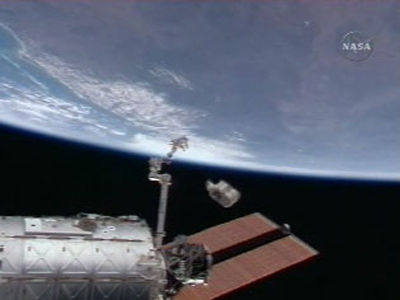Space Station Trash Plunging to Earth

This story was updated at 11:23 p.m. EDT.
A piece ofspace station trash the size of a refrigerator is poised to plunge through theEarth?s atmosphere late Sunday, more than a year after an astronaut tossed itoverboard.
NASA andthe U.S. Space Surveillance Network are tracking the object - a 1,400-pound(635-kg) tankof toxic ammonia coolant thrown from the International Space Station - tomake sure it does not endanger people on Earth. Exactly where the tank will inevitablyfall is currently unknown, though it is expected to re-enter Earth?s atmosphereSunday afternoon or later that evening, NASA officials said.
?This hasgot a very low likelihood that anybody will be impacted by it,? said MikeSuffredini, NASA?s space station program manager, in an interview. ?But still, it is a largeobject and pieces will enter and we just need to be cautious.?
NASAastronaut Clayton Anderson threwthe ammonia tank from the tip of the space station?s Canadian-built roboticarm during a July 23, 2007 spacewalk. He also tossed away an unneeded video camerastand overboard as well, but that 212-pound (96-kilogram) item burned upharmlessly in the atmosphere early this year, Suffredini said.
NASAexpects up to 15 pieces of the tank to survive the searing hot temperatures ofre-entry, ranging in size from about 1.4 ounces (40 grams) to nearly 40 pounds(17.5 kg).
If theyreach all the way to land, the largest pieces could slam into the Earth?ssurface at about 100 mph (161 kph). But a splashdown at sea is also possible, asthe planet is two-thirds ocean.
Breaking space news, the latest updates on rocket launches, skywatching events and more!
?If anybodyfound a piece of anything on the ground Monday morning, I would hope they wouldn?tget too close to it,? Suffredini said.
Known asthe Early Ammonia Servicer (EAS), the coolant tank is the largest piece oforbital trash ever tossed overboard by hand from the space station. Largerunmanned Russian and European cargo ships are routinely destroyed in theEarth?s atmosphere over the Pacific Ocean after their space station deliveries,but those disposals are controlled and preplanned.
The recentdestruction of the European Space Agency?s JulesVerne cargo ship was eagerly observed by scientists hoping to glean newinformation on how objects behave as they enter Earth?s atmosphere. Observersaboard two chase planes caught photographs and video of the double-deckerbus-sized spacecraft?s demise, but no such campaign is possible with thereturning ammonia tank.
The lastobject to re-enter the Earth?s atmosphere with prior notice was a small asteroidthe size of a kitchen table that explodedin midair as it flew over Africa on Oct. 7.
It?s takenmore than year for the ammonia tank to slowly slip down toward Earth due toatmospheric drag. During its time aboard the station, the tank served as acoolant reservoir to boost the outpost?s cooling system in the event of leaks.Upgrades to the station last year made the tank obsolete, and engineers wereconcerned that its structural integrity would not withstand a ride back toEarth aboard a NASA space shuttle.
Instead,they tossed it overboard, or ?jettisoned? it in NASA parlance.
Suffredinisaid that while astronauts have accidentally lost a tool or two duringspacewalks, the planned jettison of larger items is done with the utmost careto ensure the trash doesn?t hit the station or any other spacecraft as itcircles the Earth. Engineers also make sure the risk to people on Earth is low,as well.
?As amatter of course, we don?t throw things overboard haphazardly,? Suffredinisaid. ?We have a policy that has certain criteria we have to meet before youcan throw something overboard.?
In the event the tank re-enters over land, NASA advisedmembers of the public to contact their local authorities, or the U.S. Departmentof State via diplomatic channels if outside the U.S., if they believe they?vefound its remains.
- Video- The Fiery Demise of Europe?s Jules Verne Spaceship
- Video - Suborbital Rocket Test Explodes
- 10 MostMemorable Pieces of Space Debris

Tariq is the award-winning Editor-in-Chief of Space.com and joined the team in 2001. He covers human spaceflight, as well as skywatching and entertainment. He became Space.com's Editor-in-Chief in 2019. Before joining Space.com, Tariq was a staff reporter for The Los Angeles Times covering education and city beats in La Habra, Fullerton and Huntington Beach. He's a recipient of the 2022 Harry Kolcum Award for excellence in space reporting and the 2025 Space Pioneer Award from the National Space Society. He is an Eagle Scout and Space Camp alum with journalism degrees from the USC and NYU. You can find Tariq at Space.com and as the co-host to the This Week In Space podcast on the TWiT network. To see his latest project, you can follow Tariq on Twitter @tariqjmalik.
